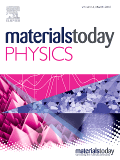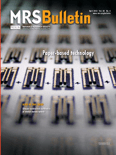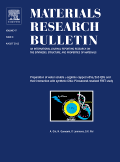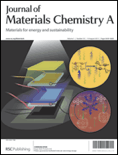
Materials Today Physics
Scope & Guideline
Connecting Academics and Industry for a Greener Tomorrow
Introduction
Aims and Scopes
- Thermoelectric Materials and Devices:
The journal emphasizes research on thermoelectric materials, exploring their properties, efficiencies, and applications in energy conversion and cooling technologies. - Nanostructured Materials:
Innovations in nanomaterials, including their synthesis, characterization, and applications in electronics, photonics, and energy storage. - Magnetocaloric and Magnetic Materials:
Research on materials exhibiting magnetocaloric effects and their potential in refrigeration and energy applications. - 2D Materials and Heterostructures:
Focus on the development and application of two-dimensional materials, including their heterostructures for various electronic and optoelectronic applications. - Electrocatalysis and Energy Conversion:
Studies on materials for electrocatalysis, particularly for hydrogen production, CO2 reduction, and other energy conversion processes. - Biomaterials and Environmental Applications:
Research on materials designed for biomedical applications and their environmental impact, including biodegradable materials and water purification technologies.
Trending and Emerging
- Machine Learning and AI in Materials Science:
The application of machine learning and artificial intelligence for materials design, discovery, and optimization is rapidly gaining traction, enabling faster and more efficient research outcomes. - Sustainable and Green Materials:
Increasing focus on sustainable materials and processes, including biodegradable polymers and eco-friendly energy solutions, is becoming a critical area of research. - Advanced Energy Materials:
There is a notable increase in research on materials for energy applications, including high-performance batteries, thermoelectrics, and fuel cells. - Flexible and Wearable Electronics:
Research on materials for flexible and wearable electronic devices is emerging as a significant trend, driven by the demand for innovative electronic applications. - Quantum Materials and Topological Phases:
Investigations into quantum materials and their unique properties, including topological insulators and superconductors, are increasingly prominent in the journal's publications.
Declining or Waning
- Traditional Bulk Materials:
Research on traditional bulk materials is becoming less prominent as the focus shifts towards advanced nanostructured and composite materials that offer superior properties. - Passive Materials without Functional Applications:
There is a decreasing trend in studies focusing solely on passive materials that do not exhibit unique functionalities or applications, as the field moves towards more application-driven research. - Low-Dimensional Materials without Novel Properties:
The exploration of low-dimensional materials that do not provide significant advancements or novel properties is waning as the community seeks more impactful discoveries.
Similar Journals

MRS BULLETIN
Advancing the Frontiers of Materials Science.MRS BULLETIN is a distinguished academic journal published by Springer Heidelberg, focusing on groundbreaking research in the fields of condensed matter physics, materials science, and theoretical chemistry. With an impressive impact factor and categorizations in the top quartile (Q1) for 2023, it ranks among the leading journals in its field, demonstrating its critical role in advancing scientific knowledge and innovation. Operating from Heidelberg, Germany, this journal serves as an essential platform for the dissemination of high-quality research, synthesizing pivotal findings and discussions that bridge academia and industry. Researchers, professionals, and students will find invaluable insights within its pages, showcasing developments that are vital for fostering innovation in materials and physical sciences. Although it is not an open access journal, its rigorous peer-review process ensures the highest standards of scholarly communication, securing its reputation as a premier resource for current trends and breakthroughs.

PHYSICA STATUS SOLIDI B-BASIC SOLID STATE PHYSICS
Illuminating Innovations in Basic Solid State ResearchPHYSICA STATUS SOLIDI B-BASIC SOLID STATE PHYSICS, published by Wiley-VCH Verlag GmbH in Germany, is an esteemed journal within the condensed matter physics sphere, covering pivotal advancements in basic solid state physics. With a rich history dating back to 1961, it serves as a scholarly platform for researchers, professionals, and students alike, providing insights into the fundamental properties and applications of electronic, optical, and magnetic materials. The journal currently holds a respectable Q3 ranking in both Condensed Matter Physics and Electronic, Optical, and Magnetic Materials as of 2023, indicating its impactful contributions to these fields despite its competitive landscape. While it does not offer open access, its comprehensive research findings are critical for those engaged in innovative material science research. With a convergence period extending to 2024, PHYSICA STATUS SOLIDI B continues to play a significant role in facilitating knowledge exchange and fostering advancements in solid state physics.

Frontiers of Materials Science
Advancing the Boundaries of Innovation in Materials ScienceFrontiers of Materials Science is a groundbreaking journal dedicated to exploring advanced materials and their applications within the ever-evolving landscape of materials science. Published by HIGHER EDUCATION PRESS, this journal offers a crucial platform for scholars and practitioners seeking to disseminate innovative research findings that foster interdisciplinary collaboration. Since its inception in 2011, the journal has enjoyed a notable Q2 ranking in the category of Materials Science (miscellaneous) as of 2023, positioning it among the noteworthy publications in the field with a Scopus rank of #222 out of 463. While predominantly published in China, the journal is committed to open access principles, allowing global accessibility to cutting-edge research. With its comprehensive coverage spanning materials synthesis, characterization, properties, and applications, Frontiers of Materials Science not only serves as a repository for academia but also bridges the gap between research and industry, making it an indispensable resource for researchers, professionals, and students alike.

Crystals
Bridging Theory and Application in Materials ScienceCrystals is a premier open-access journal, published by MDPI since 2011, that focuses on the multidisciplinary fields of chemical engineering, condensed matter physics, inorganic chemistry, and materials science. With its E-ISSN 2073-4352, the journal is headquartered in Switzerland, and actively contributes to the global scientific community by facilitating the dissemination of high-quality research. Ranking in the Q2 quartile across multiple categories, including Chemical Engineering (miscellaneous) and Materials Science (miscellaneous) for 2023, Crystals provides a platform for innovative studies that span from fundamental research to practical applications. The journal's commitment to open access ensures that groundbreaking findings are readily available to researchers, professionals, and students alike, fostering an environment of collaboration and knowledge sharing that is essential in advancing the scientific understanding of crystalline materials.

Carbon Energy
Catalyzing interdisciplinary collaboration for global energy challenges.Welcome to Carbon Energy, an esteemed open-access journal published by WILEY that focuses on cutting-edge research in the field of energy and materials science. Since its inception in 2019, this journal has quickly established itself as a leading platform for disseminating impactful findings and innovations related to carbon-based energy solutions, renewable resources, and sustainability practices. With its impressive Q1 rankings in multiple categories—including Energy (miscellaneous), Materials Chemistry, and Renewable Energy—Carbon Energy is recognized for delivering high-quality, peer-reviewed content that meets the rigorous standards of the academic community. Through its open-access model, the journal ensures wide accessibility of research findings, making it an invaluable resource for researchers, professionals, and students alike. As we look toward the future, Carbon Energy aims to further its mission of advancing sustainable energy technologies and promoting interdisciplinary collaboration in tackling global energy challenges.

EnergyChem
Catalyzing Change through Open Access Energy Research.EnergyChem is a premier academic journal published by ELSEVIER, dedicated to advancing the field of energy chemistry and its applications in sustainable technologies. With a strong focus on biomaterials and innovative chemistry solutions, the journal has established itself as a leading platform within the research community, boasting remarkable rankings such as Q1 in Biomaterials, Chemistry (miscellaneous), and Energy (miscellaneous) for 2023. Notably, it ranks 2nd in both Materials Science and Energy categories, reflecting the high caliber of research it publishes, which is crucial for tackling pressing global energy challenges. Since its inception in 2019, EnergyChem has been committed to open and accessible research, making it an invaluable resource for researchers, professionals, and students striving for cutting-edge insights in energy conversion and storage. With its target audience in mind, the journal encourages submissions that explore innovative materials, processes, and applications that will contribute to a sustainable energy future.

MATERIALS RESEARCH BULLETIN
Driving excellence in materials research and application.MATERIALS RESEARCH BULLETIN is a prestigious journal published by Pergamon-Elsevier Science Ltd, dedicated to advancing the field of materials science and engineering. Since its inception in 1966, the journal has served as a platform for high-impact research, particularly in areas such as condensed matter physics, mechanical engineering, and materials mechanics. With an impressive Q1 ranking in multiple categories, including Condensed Matter Physics and Materials Science, MATERIALS RESEARCH BULLETIN stands out as a leading resource in its domain, aiming to disseminate innovative research findings and methodologies that address fundamental and applied aspects of materials. The journal’s rigorous peer-review process ensures the publication of high-quality articles, making it an essential resource for researchers, professionals, and students alike. With its ongoing commitment to fostering scientific discourse and collaboration, MATERIALS RESEARCH BULLETIN remains at the forefront of materials research, contributing significantly to the global scientific community.

Journal of Materials Chemistry A
Leading the Charge in Sustainable Materials ResearchJournal of Materials Chemistry A, published by the Royal Society of Chemistry, stands as a leading peer-reviewed journal in the fields of Chemistry, Materials Science, and Renewable Energy. With an impressive ranking within the top quartile (Q1) across these disciplines in 2023, this journal not only showcases groundbreaking research but also addresses pivotal challenges in sustainable materials and energy. Spanning from 2013 to 2024, it serves as a vital platform for scientists and engineers to present innovative solutions and advances in materials that directly contribute to environmental sustainability. Accessible to a broad audience, the journal's contributions are essential for anyone engaged in the development of new materials and technologies that promise to shape a greener future. With a commitment to high-quality open access publishing, the Journal of Materials Chemistry A is instrumental in disseminating impactful research to enhance scholarly communication and foster collaboration in an increasingly interconnected research landscape.

Solids is a distinguished peer-reviewed journal published by MDPI, dedicated to the comprehensive exploration of the properties, applications, and advancements in solid materials. Starting its journey in 2020, this Open Access journal provides a dynamic platform for researchers and professionals in the fields of physics, astronomy, materials science, and chemistry, enabling them to disseminate their findings to a global audience without barriers. With an emerging presence in the academic landscape, Solids has established a reputation reflected in its Scopus rankings, including a commendable position of #28 out of 81 in Physics and Astronomy and #83 out of 196 in Materials Science, demonstrating its impact and relevance within these vibrant fields. The journal's objectives extend to fostering interdisciplinary discussions and collaboration, making it an essential resource for those seeking to advance their understanding of solid materials and their innovative applications. Researchers and students alike are encouraged to contribute to this essential dialogue, engaging with the latest research and insights in solid-state science from around the globe.

Advanced Energy and Sustainability Research
Driving Change through Open Access ResearchAdvanced Energy and Sustainability Research is a leading open-access journal published by WILEY since 2020, dedicated to advancing knowledge and understanding in the realms of energy and sustainability. With an impressive impact factor and a commitment to high-quality, peer-reviewed research, this journal serves an international audience of researchers, professionals, and students passionate about addressing critical environmental challenges. The journal encompasses a wide array of topics within environmental science and energy fields, securing notable rankings in Scopus with top percentiles across several categories, including Ecology, Energy Engineering and Power Technology, and Waste Management. Given its open-access model, Advanced Energy and Sustainability Research facilitates the dissemination of cutting-edge research, enhancing accessibility and fostering collaboration within the scientific community. This journal not only plays a pivotal role in shaping public policy and industry practices but also aims to inspire innovative solutions for sustainable development in an increasingly complex world.